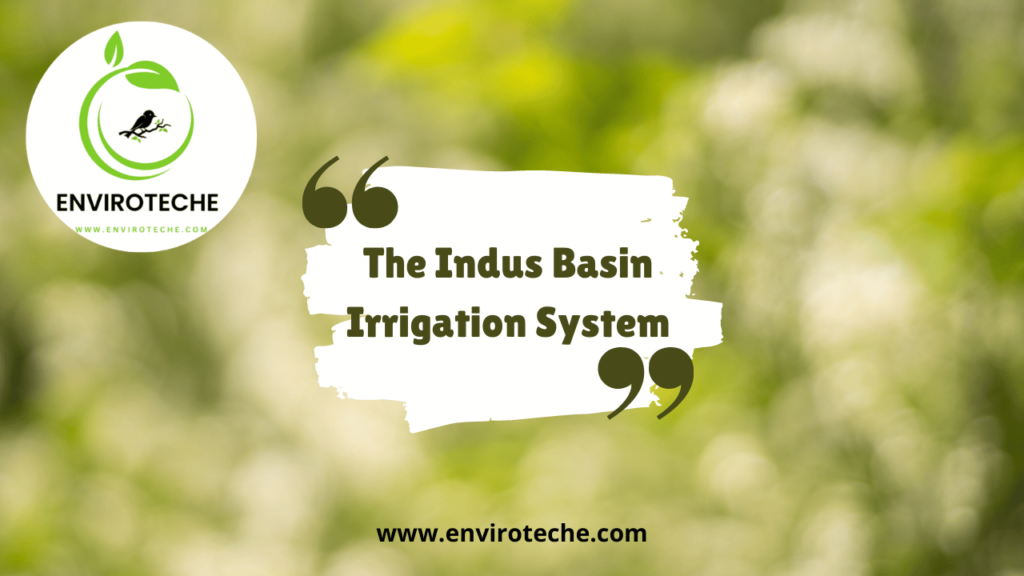
Qudrat Ullah1, Muhammad Qasim1
1Departmental of Environmental Sciences, Government College University Faisalabad
Introduction:
With an employment rate of close to 40% and a GDP contribution of roughly 18%, agriculture is a crucial component of Pakistan’s economy (Ashraf & Ismat, 2016; Khan et al., 2021). The Indus Basin Irrigation System (IBIS), one of the world’s largest contiguous irrigation systems, which covers an area of more than 43 million acres, is a major source of water for this industry. The IBIS has been essential to Pakistan’s economic development and has allowed the nation to become self-sufficient in the production of wheat and rice (Azam & Shafique, 2017; Chandio et al., 2019).
However, there is now a serious problem with the IBIS’s overuse of its underground water resources. Excessive groundwater pumping for irrigation has depleted water tables, which has caused aquifers to deteriorate and reduced water availability for future generations. The risk of land subsidence, which can harm infrastructure and result in floods in the affected areas, has also increased as a result of the groundwater depletion. The overuse of underground water resources in the IBIS is a complicated, multifaceted problem. Numerous factors, such as population growth, urbanisation, and modifications in crop patterns, have contributed to it.
A further factor in the depletion of groundwater resources is the inefficient use of water in agriculture. Additionally, the issue has been made worse by inadequate groundwater resource monitoring and management. The adoption of contemporary irrigation methods, the promotion of water-efficient crops, and the implementation of regulations to control groundwater extraction are just a few of the measures that have been suggested to address the issue of overexploitation of underground water resources in the IBIS. The government has also started initiatives to recharge groundwater through small dam construction and rainwater harvesting. Ultimately, the Indus Basin Irrigation System has been essential in assisting
Pakistan’s agricultural sector, but the overuse of underground water resources has emerged as a serious issue. It is essential to adopt a comprehensive strategy that incorporates effective water management, contemporary irrigation techniques, and the promotion of water-efficient crops in order to ensure the sustainable use of groundwater resources in the IBIS. To address this issue and secure the future of Pakistan’s agriculture sector, the government, civil society, and other stakeholders must collaborate.
Indus Basin Irrigation System (IBIS):
One of the world’s largest contiguous irrigation systems, the Indus Basin Irrigation System (IBIS) irrigates roughly 181 million acres of land in Pakistan. The system was created in response to the need for greater agricultural output in the Indus River Basin, and it has since been instrumental in assisting Pakistan’s agriculture industry (Kidwai et al., 2019; Peña-Arancibia et al., 2021).
A system of canals, barrages, and dams known as the IBIS is used to divert water from the Indus River and its tributaries for agricultural irrigation. The Upper Indus Basin, Middle Indus Basin, and Lower Indus Basin are the three main basins that make up the system. The Tarbela Dam, the biggest earth-filled dam in the world, is part of the Upper Indus Basin and supplies irrigation water to Pakistan’s northern regions. The Mangla Dam, the seventh-largest earth-filled dam in the world, is part of the Middle Indus Basin and provides irrigation water to Pakistan’s central regions. The Sukkur Barrage, part of the Lower Indus Basin, diverts water to Pakistan’s southern regions (Atif et al., 2021; Syvitski & Brakenridge, 2013).
For Pakistan’s agriculture sector, which employs about 40% of the nation’s workforce and contributes about 20% of the GDP, the IBIS is of utmost importance. The system enables year-round crop irrigation, allowing for multiple cropping seasons and higher crop yields. It also enables the construction of fish farms and provides water for livestock. By boosting agricultural productivity and generating employment opportunities, the IBIS has significantly contributed to the reduction of poverty in rural areas.
Despite its significance, the IBIS encounters a number of difficulties, including a lack of water, ineffective methods of water management, and inadequate infrastructure. Climate change and excessive groundwater extraction have made the water shortage problem worse. Significant losses have resulted from ineffective water management practises because of evaporation, seepage, and other issues. Water losses and decreased efficiency have also been caused by inadequate infrastructure, including antiquated canals and irrigation systems.
The Pakistani government has launched a number of initiatives to address these issues, with the goals of enhancing water management and boosting IBIS effectiveness. These include building new dams, repairing existing infrastructure, promoting contemporary irrigation methods, and putting water conservation measures in place. The success of these initiatives will be essential for maintaining the IBIS’s viability and Pakistan’s agriculture sector’s long-term sustainability.
Overexploitation of Underground Water Resources in IBIS:
Overexploitation of IBIS’s underground water resources is a serious issue. Rapid population growth, urbanisation, and industrialization are the main contributors to this overexploitation. The problem has also been exacerbated by a lack of policies and regulations governing water management. Land subsidence, waterlogging, and salinization are consequences of the alarming rate at which the aquifers in IBIS are being depleted.
Water is becoming less readily available for use in industry, agriculture, and drinking due to the depletion of aquifers. The ground is sinking as a result of the excessive groundwater pumping that is causing the land to subside. This phenomenon raises the possibility of flooding while also harming infrastructure like buildings and roads. Excessive irrigation in some areas is causing the water table to rise and bringing salts to the surface, resulting in waterlogging and salinization. This renders the soil unusable for farming and may have negative environmental effects.
Overall, IBIS’s groundwater resources are in a worrying state right now, and immediate action is required to fix the problem. The problem of overexploitation can be lessened and water resources can be made available for future generations by implementing efficient water management policies and regulations and promoting sustainable practises like rainwater harvesting and effective irrigation methods.
Solutions to Overexploitation of Underground Water Resources in IBIS:
The overuse of underground water resources in IBIS is a serious problem that needs quick fixes. The implementation of policies and regulations for water management is one of the best solutions. This includes setting up water use caps and keeping an eye on water extraction to make sure it stays within sustainable limits. Overexploitation can also be discouraged by the application of penalties and fines for violations of water use regulations. Utilising contemporary irrigation technologies can also aid in lowering water usage and increasing effectiveness. This includes the use of drip irrigation, which delivers water directly to plant roots, minimising evaporation and runoff losses.
Implementing water-saving techniques like crop rotation, mulching, and cover crops is another option because they can help the soil retain moisture and lessen the need for irrigation. The use of alternative water sources, such as wastewater treatment and rainwater harvesting, can also aid in lowering the demand for underground water supplies. The overexploitation of underground water resources in IBIS must be reduced, and public awareness and education are essential. People can be inspired to adopt more sustainable practises in their daily lives by spreading awareness of the value of water conservation and the effects of overexploitation.
Conclusion:
The significance of the Indus Basin Irrigation System (IBIS) for Pakistan’s agriculture must be emphasised, to sum up. IBIS, which supplies irrigation water to about 42 million acres of land in Pakistan, is the world’s largest contiguous irrigation system. By increasing agricultural productivity, this system has significantly improved the nation’s food security and reduced poverty. But the overuse of underground water resources in IBIS is a serious problem that needs to be addressed right away. The rapid drop in the water table caused by excessive groundwater pumping will have long-term detrimental effects on the environment and agriculture.
Implementing sustainable water management strategies that encourage water conservation, effective irrigation systems, and the adoption of crop patterns that require less water are crucial for resolving this issue. In order to find and promote alternative water sources, such as rainwater harvesting and wastewater reuse, it is also critical to invest in research and development. Finally, to address the growing problem of water scarcity in Pakistan and to ensure the long-term viability of IBIS and the agricultural sector, sustainable water management practises are required. Indus Basin
References:
Ashraf, M. A., & Ismat, H. I. (2016). Education and development of Pakistan: A study of current situation of education and literacy in Pakistan. US-China Education Review B, 6(11), 647-654. Indus Basin
Atif, S., Umar, M., & Ullah, F. (2021). Investigating the flood damages in Lower Indus Basin since 2000: Spatiotemporal analyses of the major flood events. Natural Hazards, 108(2), 2357-2383. Indus Basin
Azam, A., & Shafique, M. (2017). Agriculture in Pakistan and its Impact on Economy. A Review. Inter. J. Adv. Sci. Technol, 103, 47-60. Indus Basin
Chandio, A. A., Jiang, Y., Gessesse, A. T., & Dunya, R. (2019). The nexus of agricultural credit, farm size and technical efficiency in Sindh, Pakistan: A stochastic production frontier approach. Journal of the Saudi Society of Agricultural Sciences, 18(3), 348-354. Indus Basin
Khan, N., Ullah, R., Khan, N., Naseem, M., Farhatullah, M. R., Khan, N. U., & Siddiqui, B. (2021). Agricultural extension worker role in the transfer of garlic production technology: a case study of Balochistan province, Pakistan. Int. J. Biosci.(IJB), 18, 26-35.
Kidwai, S., Ahmed, W., Tabrez, S. M., Zhang, J., Giosan, L., Clift, P., & Inam, A. (2019). The Indus delta—catchment, river, coast, and people Coasts and Estuaries (pp. 213-232): Elsevier.
Peña-Arancibia, J. L., Stewart, J. P., & Kirby, J. M. (2021). Water balance trends in irrigated canal commands and its implications for sustainable water management in Pakistan: Evidence from 1981 to 2012. Agricultural Water Management, 245, 106648.
Syvitski, J. P., & Brakenridge, G. R. (2013). Causation and avoidance of catastrophic flooding along the Indus River, Pakistan. GsA today, 23(1), 4-10.
Check Other Schlorships:

